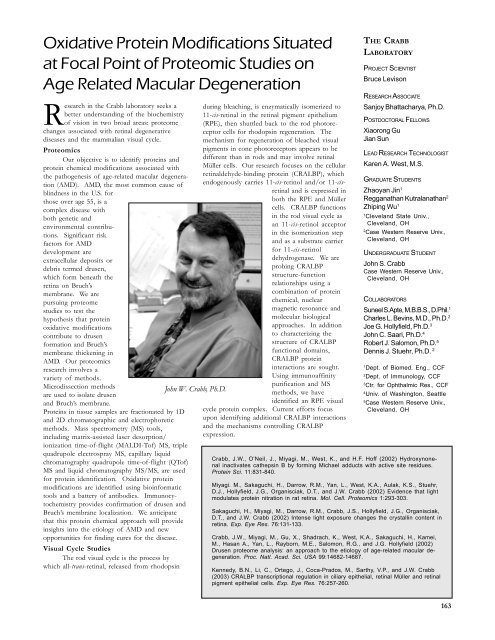Scientific Report 2003-2004 - Cleveland Clinic Lerner Research ...
Scientific Report 2003-2004 - Cleveland Clinic Lerner Research ...
Scientific Report 2003-2004 - Cleveland Clinic Lerner Research ...
- No tags were found...
You also want an ePaper? Increase the reach of your titles
YUMPU automatically turns print PDFs into web optimized ePapers that Google loves.
Oxidative Protein Modifications Situatedat Focal Point of Proteomic Studies onAge Related Macular Degeneration<strong>Research</strong> in the Crabb laboratory seeks abetter understanding of the biochemistryof vision in two broad areas: proteomechanges associated with retinal degenerativediseases and the mammalian visual cycle.ProteomicsOur objective is to identify proteins andprotein chemical modifications associated withthe pathogenesis of age-related macular degeneration(AMD). AMD, the most common cause ofblindness in the U.S. forthose over age 55, is acomplex disease withboth genetic andenvironmental contributions.Significant riskfactors for AMDdevelopment areextracellular deposits ordebris termed drusen,which form beneath theretina on Bruch’smembrane. We arepursuing proteomestudies to test thehypothesis that proteinoxidative modificationscontribute to drusenformation and Bruch’smembrane thickening inAMD. Our proteomicsresearch involves avariety of methods.Microdissection methodsare used to isolate drusenand Bruch’s membrane.Proteins in tissue samples are fractionated by 1Dand 2D chromatographic and electrophoreticmethods. Mass spectrometry (MS) tools,including matrix-assisted laser desorption/ionization time-of-flight (MALDI-Tof) MS, triplequadrupole electrospray MS, capillary liquidchromatography quadrupole time-of-flight (QTof)MS and liquid chromatography MS/MS, are usedfor protein identification. Oxidative proteinmodifications are identified using bioinformatictools and a battery of antibodies. Immunocytochemistryprovides confirmation of drusen andBruch’s membrane localization. We anticipatethat this protein chemical approach will provideinsights into the etiology of AMD and newopportunities for finding cures for the disease.Visual Cycle StudiesThe rod visual cycle is the process bywhich all-trans-retinal, released from rhodopsinJohn W. Crabb, Ph.D.during bleaching, is enzymatically isomerized to11-cis-retinal in the retinal pigment epithelium(RPE), then shuttled back to the rod photoreceptorcells for rhodopsin regeneration. Themechanism for regeneration of bleached visualpigments in cone photoreceptors appears to bedifferent than in rods and may involve retinalMüller cells. Our research focuses on the cellularretinaldehyde-binding protein (CRALBP), whichendogenously carries 11-cis-retinol and/or 11-cisretinaland is expressed inboth the RPE and Müllercells. CRALBP functionsin the rod visual cycle asan 11-cis-retinol acceptorin the isomerization stepand as a substrate carrierfor 11-cis-retinoldehydrogenase. We areprobing CRALBPstructure-functionrelationships using acombination of proteinchemical, nuclearmagnetic resonance andmolecular biologicalapproaches. In additionto characterizing thestructure of CRALBPfunctional domains,CRALBP proteininteractions are sought.Using immunoaffinitypurification and MSmethods, we haveidentified an RPE visualcycle protein complex. Current efforts focusupon identifying additional CRALBP interactionsand the mechanisms controlling CRALBPexpression.THE CRABBLABORATORYPROJECT SCIENTISTBruce LevisonRESEARCH ASSOCIATESanjoy Bhattacharya, Ph.D.POSTDOCTORAL FELLOWSXiaorong GuJian SunLEAD RESEARCH TECHNOLOGISTKaren A. West, M.S.GRADUATE STUDENTSZhaoyan Jin 1Regganathan Kutralanathan 2Zhiping Wu 11<strong>Cleveland</strong> State Univ.,<strong>Cleveland</strong>, OH2Case Western Reserve Univ.,<strong>Cleveland</strong>, OHUNDERGRADUATE STUDENTJohn S. CrabbCase Western Reserve Univ.,<strong>Cleveland</strong>, OHCOLLABORATORSSuneel S.Apte, M.B.B.S., D.Phil. 1Charles L. Bevins, M.D., Ph.D. 2Joe G. Hollyfield, Ph.D. 3John C. Saari, Ph.D. 4Robert J. Salomon, Ph.D. 5Dennis J. Stuehr, Ph.D. 21Dept. of Biomed. Eng., CCF2Dept. of Immunology, CCF3Ctr. for Ophthalmic Res., CCF4Univ. of Washington, Seattle5Case Western Reserve Univ.,<strong>Cleveland</strong>, OHCrabb, J.W., O’Neil, J., Miyagi, M., West, K., and H.F. Hoff (2002) Hydroxynonenalinactivates cathepsin B by forming Michael adducts with active site residues.Protein Sci. 11:831-840.Miyagi. M., Sakaguchi, H., Darrow, R.M., Yan, L., West, K.A., Aulak, K.S., Stuehr,D.J., Hollyfield, J.G., Organisciak, D.T., and J.W. Crabb (2002) Evidence that lightmodulates protein nitration in rat retina. Mol. Cell. Proteomics 1:293-303.Sakaguchi, H., Miyagi, M., Darrow, R.M., Crabb, J.S., Hollyfield, J.G., Organisciak,D.T., and J.W. Crabb (2002) Intense light exposure changes the crystallin content inretina. Exp. Eye Res. 76:131-133.Crabb, J.W., Miyagi, M., Gu, X., Shadrach, K., West, K.A., Sakaguchi, H., Kamei,M., Hasan A., Yan, L., Rayborn, M.E., Salomon, R.G., and J.G. Hollyfield (2002)Drusen proteome analysis: an approach to the etiology of age-related macular degeneration.Proc. Natl. Acad. Sci. USA 99:14682-14687.Kennedy, B.N., Li, C., Ortego, J., Coca-Prados, M., Sarthy, V.P., and J.W. Crabb(<strong>2003</strong>) CRALBP transcriptional regulation in ciliary epithelial, retinal Müller and retinalpigment epithelial cells. Exp. Eye Res. 76:257-260.163
















